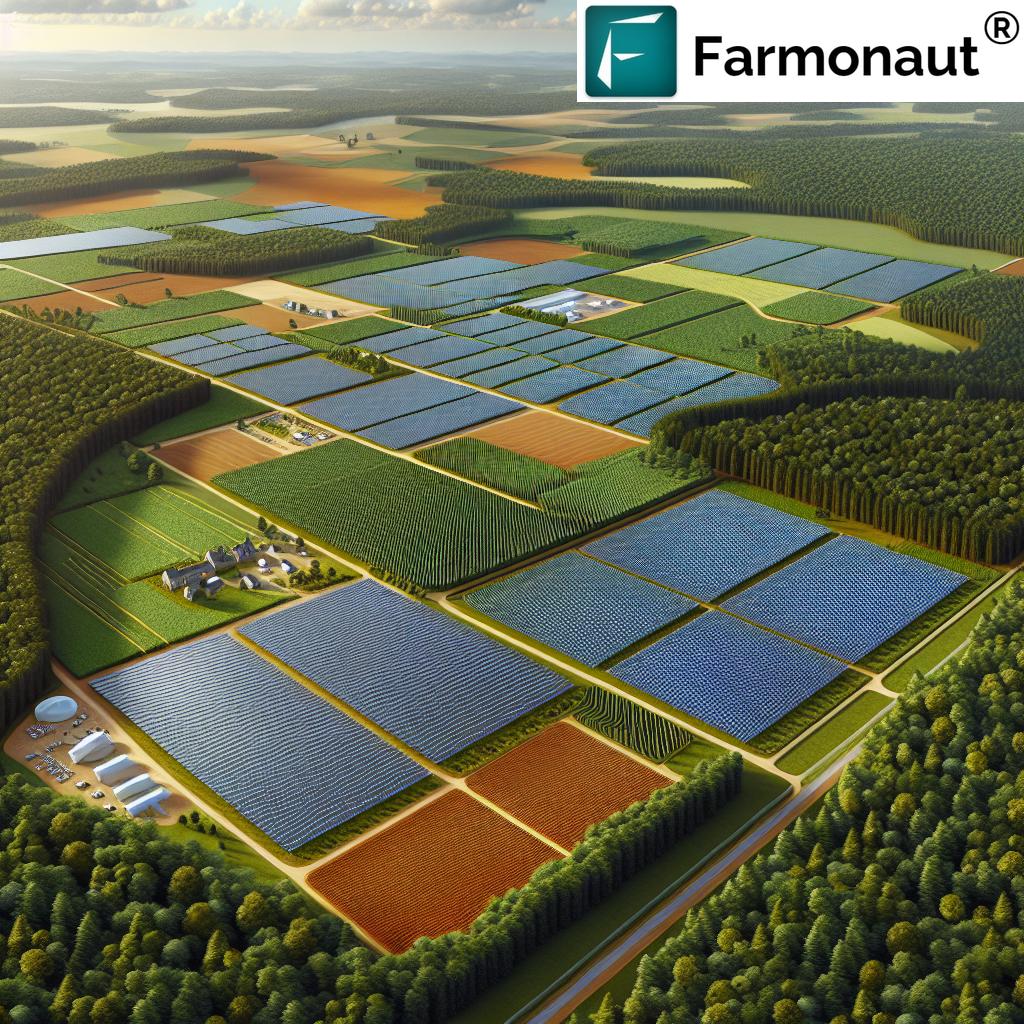Revolutionizing Wisconsin Agriculture: How GMOs and Smart Farming Are Shaping Sustainable Food Production

“GMO crops have increased global farm income by $225 billion from 1996 to 2018, boosting agricultural productivity.”
In the heart of America’s Dairyland, a revolution is taking place. Wisconsin, known for its picturesque farms and bountiful harvests, is at the forefront of a transformation that’s reshaping agriculture as we know it. As we delve into the world of GMOs (Genetically Modified Organisms) and smart farming techniques, we’ll explore how these innovations are not just changing the face of farming but also addressing some of the most pressing challenges in food production and sustainability.
In this comprehensive blog post, we’ll take you on a journey through the fields of Wisconsin, where cutting-edge technology meets traditional farming wisdom. We’ll explore how GMO crop benefits and sustainable agriculture practices are working hand in hand to create a more resilient and productive agricultural sector. From the cornfields of Green Bay to the soybean farms of Madison, we’re witnessing a revolution that promises to change the way we grow, harvest, and think about our food.
The GMO Revolution in Wisconsin
Genetically modified organisms have been a topic of intense debate since their introduction to agriculture. However, in Wisconsin, farmers are increasingly turning to GMO crops as a solution to various agricultural challenges. Let’s break down what GMOs are and how they’re impacting Wisconsin’s agricultural landscape.
Understanding GMOs
GMOs are organisms whose genetic material has been altered using genetic engineering techniques. In agriculture, this typically involves introducing genes from one species into another to create crops with desirable traits. These traits can include:
- Increased resistance to pests and diseases
- Enhanced tolerance to herbicides
- Improved nutritional content
- Greater yield potential
- Better adaptation to adverse weather conditions
In Wisconsin, the adoption of GMO crops has been significant, particularly in corn and soybean production. These genetically modified seeds are designed to thrive in the state’s unique climate and soil conditions, offering farmers new opportunities to increase yields while reducing their environmental impact.
GMO Crop Benefits in Wisconsin
The benefits of GMO crops in Wisconsin are multifaceted, touching on various aspects of agricultural production and sustainability:
- Increased Yields: GMO corn and soybean varieties have shown consistently higher yields compared to their conventional counterparts. This increase in productivity is crucial for meeting the growing demand for food and feed.
- Pest Resistance: Many GMO crops are engineered to produce their own pesticides, reducing the need for chemical sprays. This not only cuts down on input costs for farmers but also minimizes the environmental impact of pesticide use.
- Herbicide Tolerance: Herbicide-tolerant GMO crops allow for more effective weed control, reducing competition for nutrients and water. This can lead to healthier crops and higher yields.
- Drought Tolerance: With climate change bringing more frequent droughts, GMO crops designed to withstand water stress are becoming increasingly valuable to Wisconsin farmers.
- Reduced Environmental Impact: By requiring fewer pesticides and enabling conservation tillage practices, GMO crops can help reduce soil erosion and greenhouse gas emissions.
These benefits are not just theoretical. Wisconsin farmers have reported significant improvements in their operations since adopting GMO crops. From reduced crop losses due to pests to increased profitability through higher yields, the impact has been substantial.
Addressing Concerns and Misconceptions
Despite the many benefits, GMOs remain a controversial topic. It’s important to address some common concerns:
- Safety: Numerous scientific studies have concluded that GMO foods are safe for human consumption. Rigorous testing and regulatory oversight ensure that GMO crops meet strict safety standards.
- Environmental Impact: While concerns about biodiversity exist, GMO crops can actually contribute to conservation efforts by reducing the need for land expansion and chemical inputs.
- Nutritional Value: Some GMO crops, like golden rice, are specifically designed to enhance nutritional content, addressing deficiencies in certain populations.
As we continue to research and develop GMO technologies, it’s crucial to maintain an open dialogue between scientists, farmers, and consumers to ensure that these innovations are used responsibly and effectively.
Smart Farming: The Future of Agriculture in Wisconsin

“Precision farming techniques can reduce water usage in agriculture by up to 30%, promoting sustainable resource management.”
While GMOs are revolutionizing crop genetics, smart farming technologies are transforming how these crops are grown and managed. In Wisconsin, farmers are increasingly adopting precision farming techniques and other innovative technologies to optimize their operations.
Precision Farming Techniques
Precision farming uses technology to make farming more accurate and controlled. Here are some key techniques being used in Wisconsin:
- GPS-guided tractors: These allow for more precise planting and harvesting, reducing overlap and improving efficiency.
- Soil sensors: These devices monitor soil moisture, temperature, and nutrient levels, allowing farmers to make data-driven decisions about irrigation and fertilization.
- Drone technology: Drones equipped with cameras and sensors can survey large areas quickly, helping farmers identify issues like pest infestations or crop diseases early.
- Variable rate technology: This allows farmers to apply different amounts of inputs (like seeds, fertilizers, or pesticides) to different parts of a field based on need, reducing waste and improving yields.
These precision farming techniques are not just improving efficiency; they’re also contributing to more sustainable farming practices by optimizing resource use.
Smart Farming for Resource Conservation
One of the most significant benefits of smart farming is its potential for resource conservation. In Wisconsin, where water management and soil health are crucial concerns, these technologies are making a real difference:
- Water Conservation: Precision irrigation systems can reduce water usage by applying water only where and when it’s needed, based on real-time soil moisture data.
- Fertilizer Optimization: By precisely mapping soil nutrient levels, farmers can apply fertilizers more efficiently, reducing runoff and protecting water quality.
- Fuel Efficiency: GPS-guided machinery and optimized field operations can significantly reduce fuel consumption, lowering both costs and carbon emissions.
- Soil Health: Smart farming practices like precision tillage and cover crop management help preserve soil structure and reduce erosion.
These resource conservation efforts are not just good for the environment; they’re also improving the bottom line for Wisconsin farmers by reducing input costs and improving long-term soil fertility.
The Role of Data in Smart Farming
At the heart of smart farming is data. Wisconsin farmers are increasingly relying on data analytics to make informed decisions about their operations. This includes:
- Yield mapping: Analyzing data from previous harvests to identify high and low-performing areas of fields.
- Weather forecasting: Using advanced weather data to plan planting, harvesting, and other critical activities.
- Market analysis: Leveraging data on market trends to make informed decisions about crop selection and timing of sales.
By harnessing the power of data, Wisconsin farmers are not just reacting to conditions; they’re proactively managing their farms for optimal performance and sustainability.
The Intersection of GMOs and Smart Farming
While GMOs and smart farming technologies are powerful on their own, their true potential is realized when they’re used together. In Wisconsin, we’re seeing exciting developments at the intersection of these two innovations:
Precision Breeding
Advanced genetic technologies are allowing for more precise and efficient breeding of new crop varieties. This means that GMO crops can be tailored even more specifically to Wisconsin’s unique growing conditions and challenges.
Data-Driven Crop Management
Smart farming technologies are helping farmers get the most out of their GMO crops. For example, precision application of herbicides to herbicide-resistant GMO crops can maximize weed control while minimizing chemical use.
Enhanced Sustainability
The combination of GMO crops engineered for resource efficiency and smart farming technologies that optimize resource use is creating a powerful synergy for sustainable agriculture in Wisconsin.
The Impact on Wisconsin’s Agricultural Economy
The adoption of GMOs and smart farming technologies is having a significant impact on Wisconsin’s agricultural economy:
- Increased Productivity: Higher yields and more efficient resource use are boosting overall agricultural output.
- Cost Savings: Reduced input costs are improving profit margins for farmers.
- New Job Opportunities: The rise of agtech is creating new jobs in areas like data analysis, precision equipment operation, and agricultural biotechnology.
- Export Opportunities: Increased production and high-quality crops are opening up new export markets for Wisconsin agricultural products.
These economic benefits are helping to secure the future of farming in Wisconsin, making it a more attractive and viable career for the next generation of farmers.
Challenges and Future Directions
While the benefits of GMOs and smart farming are clear, there are still challenges to be addressed:
- Initial Investment Costs: The upfront costs of adopting new technologies can be significant, especially for smaller farms.
- Skills Gap: There’s a need for education and training to help farmers fully leverage these new technologies.
- Data Privacy and Security: As farms become more connected, ensuring the security and privacy of farm data is crucial.
- Regulatory Environment: Keeping regulations up to date with rapidly advancing technologies is an ongoing challenge.
Looking to the future, we can expect to see continued innovation in both GMO development and smart farming technologies. Areas of focus may include:
- Development of GMO crops with enhanced nutritional profiles
- Integration of artificial intelligence and machine learning in farm management systems
- Advancements in indoor and vertical farming technologies
- Continued improvements in resource efficiency and environmental sustainability
The Role of Farmonaut in Wisconsin’s Agricultural Revolution
As we discuss the transformation of Wisconsin’s agricultural landscape, it’s important to highlight the role of innovative companies like Farmonaut in driving this change. Farmonaut offers advanced, satellite-based farm management solutions that are helping Wisconsin farmers embrace precision agriculture and smart farming practices.
Through its platform, Farmonaut provides:
- Real-time crop health monitoring: Using satellite imagery to give farmers up-to-date information on their crops’ health and development.
- AI-based advisory systems: Providing personalized recommendations for crop management based on data analysis.
- Resource management tools: Helping farmers optimize their use of water, fertilizers, and other inputs.
These tools are particularly valuable for Wisconsin farmers managing GMO crops, as they allow for precise monitoring and management to maximize the benefits of these advanced crop varieties.
To learn more about how Farmonaut can support your farming operations, visit their website or download their mobile app:
Comparison: Traditional vs. GMO Crops in Wisconsin
| Aspect | Traditional Crops | GMO Crops |
|---|---|---|
| Average Corn Yield (bushels/acre) | 150-170 | 180-200 |
| Pest Resistance | Low-Medium | High |
| Drought Tolerance | Low | Medium-High |
| Herbicide Resistance | No | Yes |
| Nutritional Enhancement | No | Possible (e.g., higher protein content) |
| Estimated Water Usage | High | Medium |
| Estimated Fertilizer Usage | High | Medium |
| Environmental Impact | Medium-High | Low-Medium |
This table illustrates the significant advantages that GMO crops offer in terms of yield, resistance to pests and environmental stresses, and reduced resource usage. These benefits are particularly important in Wisconsin’s agricultural context, where maximizing productivity while minimizing environmental impact is crucial.
The Future of Food Security in Wisconsin and Beyond
As we look to the future, the combination of GMO crops and smart farming technologies holds tremendous promise for addressing food security challenges, not just in Wisconsin, but globally. Here’s how:
- Increased Yields: By producing more food on existing farmland, we can meet growing demand without expanding agricultural areas.
- Climate Resilience: GMO crops designed to withstand extreme weather conditions can help ensure stable food production in the face of climate change.
- Nutritional Enhancement: Biofortified crops like golden rice can help address nutritional deficiencies in vulnerable populations.
- Reduced Food Waste: Smart farming technologies can improve post-harvest handling and storage, reducing food waste throughout the supply chain.
Wisconsin, with its strong agricultural tradition and embrace of innovation, is well-positioned to lead the way in developing and implementing these solutions.
Conclusion: A Sustainable Future for Wisconsin Agriculture
As we’ve explored throughout this blog post, the intersection of GMOs and smart farming technologies is revolutionizing agriculture in Wisconsin. From increased yields and enhanced sustainability to improved resource management and economic benefits, these innovations are shaping a new era of food production.
While challenges remain, the potential benefits for farmers, consumers, and the environment are immense. As Wisconsin continues to lead the way in adopting and refining these technologies, it’s paving the path for a more sustainable and productive agricultural future.
The revolution in Wisconsin’s fields is just beginning, and its impacts will be felt far beyond the state’s borders. As we move forward, continued research, innovation, and collaboration between farmers, scientists, and technology providers like Farmonaut will be key to realizing the full potential of these transformative technologies.
For those interested in learning more about how satellite technology and AI are revolutionizing agriculture, check out these informative videos:
FAQs
- Are GMO crops safe for consumption?
Yes, extensive scientific research has shown that GMO crops are as safe as their non-GMO counterparts for human and animal consumption. - How do GMO crops benefit Wisconsin farmers?
GMO crops offer benefits such as increased yields, pest and disease resistance, and improved tolerance to environmental stresses, helping farmers improve productivity and reduce input costs. - What is precision farming, and how does it work?
Precision farming uses technology like GPS, sensors, and data analytics to optimize farming practices, allowing for more efficient use of resources and improved crop management. - How does smart farming contribute to sustainability?
Smart farming technologies help reduce water and chemical usage, minimize soil erosion, and lower greenhouse gas emissions, contributing to more sustainable agricultural practices. - Can small farms benefit from these technologies?
While there may be initial investment costs, many smart farming technologies are scalable and can provide significant benefits to farms of all sizes, including improved efficiency and reduced input costs.
As we continue to innovate and adapt, the future of Wisconsin agriculture looks bright, promising a more sustainable, productive, and resilient food system for generations to come.















